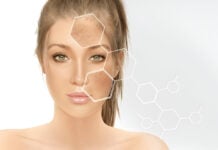In the age of smartphones and laptops, it’s no surprise that our bodies are adapting in unintended ways. While “tech neck” once referred mainly to neck pain from looking down at devices, dermatologists are now raising alarms about its impact on appearance, particularly skin aging in the neck and jawline. The modern obsession with screens is silently contributing to fine lines, sagging, and horizontal neck wrinkles in people younger than ever before. So, is tech neck and skin aging a real concern or just a passing buzzword? Let’s take a closer look.
What Is Tech Neck?
Tech neck refers to the repetitive strain and poor posture caused by constantly looking down at smartphones, tablets, and laptops. On average, a person spends 3 to 5 hours a day on their phone with their neck bent forward, which can create up to 60 pounds of pressure on the cervical spine (Hansraj, 2014). Over time, this posture leads to structural and aesthetic changes:
- Horizontal lines across the neck
- Premature skin laxity and sagging
- Jowls and double chin appearance
- Crepey skin texture
This mechanical movement, combined with thin, delicate skin on the neck, makes the area especially vulnerable to visible aging.
Why the Neck Ages Faster Than You Think
Unlike the face, the neck has fewer oil glands, less collagen, and a thinner dermis, making it more susceptible to dehydration and laxity. When compounded by constant downward motion and screen exposure, the skin quickly begins to show signs of wear:
- Repetitive creasing causes lines that become permanent
- Sun damage from UV exposure without SPF protection worsens pigmentation and texture
- Blue light from screens may increase oxidative stress, contributing to skin aging (Zastrow et al., 2009)
Even in your 20s or 30s, a creased neck may betray your age or even make you look older than you are.
Signs of Tech Neck Aging
-
Horizontal Neck Lines (Necklace Lines)
Often the first sign of tech neck, these lines deepen with prolonged screen use. -
Skin Laxity and Sagging Jawline
Constant downward gaze leads to loss of definition in the jaw and jowls. -
Crepey Skin Texture
Thin, delicate neck skin becomes dry and loses elasticity over time. -
Double Chin Appearance
Weakening of the platysma muscle and fat deposition can worsen chin and neck contours.
Prevention and Treatment: What Can You Do?
1. Correct Your Posture
- Hold devices at eye level whenever possible
- Sit with a straight back and relaxed shoulders
- Take frequent breaks from screens and stretch your neck
2. Apply Neck-Specific Skincare
- Use moisturizers and serums with peptides, hyaluronic acid, and antioxidants
- Apply broad-spectrum sunscreen to the neck and chest daily
- Incorporate retinoids gradually to boost collagen
3. In-Clinic Treatments
- Botox can soften horizontal lines and relax platysma bands
- Dermal Fillers help smooth out deeper creases
- Microneedling with Radiofrequency (RF) stimulates collagen and tightens skin
- Ultrasound-Based Devices (e.g., Ultherapy) offer non-invasive lifting of jawline and neck
- Laser Resurfacing or BBL improves pigmentation and texture from sun and blue light exposure
4. Lifestyle Tweaks
- Stay hydrated and avoid smoking
- Sleep with your head elevated to prevent skin folding
- Eat a diet rich in collagen-boosting nutrients like vitamin C, zinc, and amino acids
Psychological and Social Impact
Tech neck is more than a cosmetic issue. For many people, early signs of neck aging lead to self-consciousness, especially in video calls or selfies. This rise in “Zoom dysmorphia” has driven a growing interest in preventive aesthetic treatments (Rice et al., 2021). Recognizing these concerns early can help individuals make informed, healthy decisions about their appearance and wellbeing.
Tech neck and skin aging are very real effects of our modern, screen-focused lives. While technology isn’t going anywhere, being mindful of how we engage with it, from posture to skincare, can help minimize its impact on our skin. With the right habits and treatments, it’s possible to reclaim your neck’s youthful contour and keep your digital lifestyle from showing up in the mirror.
References
- Hansraj, K. K. (2014). Assessment of stresses in the cervical spine caused by posture and position of the head. Surgical Technology International, 25, 277–279.
- Zastrow, L., Groth, N., Klein, F., Kockott, D., Lademann, J., Ferrero, L., & Doucet, O. (2009). The missing link: light-induced (280–1600 nm) free radical formation in human skin. Skin Pharmacology and Physiology, 22(1), 31–44. https://doi.org/10.1159/000178874
- Rice, S. M., Siegel, J. A., Libby, T. L., & Graber, E. M. (2021). Zooming into cosmetic procedures during the COVID-19 pandemic: The provider’s perspective. International Journal of Women’s Dermatology, 7(2), 213–216. https://doi.org/10.1016/j.ijwd.2020.11.003












